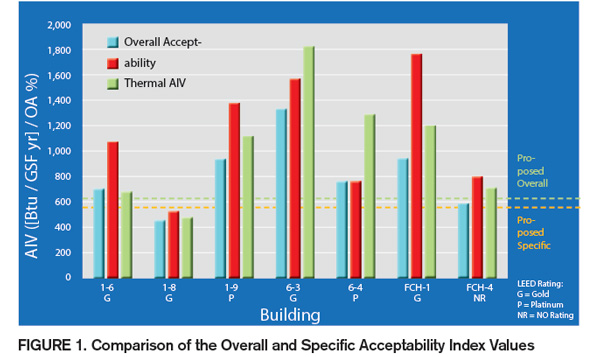AIV Metric Can Build Accountability into Building Performance
Research, new metrics show the often overlooked relationship between energy efficiency and occupant comfort helps to define a truly high-performance building. Part 4 of a 5-part article.
A look at the AIV information assembled from building reports on seven structures underscores how this metric can build accountability into building performance. The data is from two reports, one from the National Center for Energy Management and Building Technologies (NCEMBT) and the other from the National Institute of Building Sciences (NIBS).
Figure 1 (below) shows the Overall AIV as indicated in Table 1 (found in Part 3), together with corresponding Specific AIVs for thermal and acoustic acceptability from the seven buildings. Specific AIVs for lighting and odor could not be determined as the occupant responses to these exposures could not be validated for all of the buildings in these data sets.
The proposed goals for the Overall and Specific AIVs are 700 and 600, respectively. As shown in Figure 1, the Overall AIVs for four of the buildings (i.e., 1-6, 1-8, 6-4, and FCH-4) were close to or within the proposed goal of 700. However, with the exception of Building 1-8, all of the Specific AIVs were larger than the Specific AIV goal of 600 and larger than the corresponding Overall AIVs for the buildings.
Only Building 1-8 had both the Overall and Specific AIVs below the proposed goals and would qualify for further evaluation as a "high-performance building."
Conversely, four of the buildings, 1-9, 6-3, 6-4, and FCH-1, had AIVs that were substantially higher than the proposed goals and are indicative of buildings in which improvements in system performance are likely to result in reduced energy use and increased occupant acceptability.
A comparison of the Overall and Specific AIVs to the goals of 700 and 600, respectively, provides a measure of the effectiveness of energy use: If the values are less than the goals, the effectiveness of energy use can be considered to meet expectations; otherwise, the AIVs indicate that either excessive energy is being used, systems are not performing adequately to provide for the expected environmental acceptability, or both.
The Overall and Specific AIVs that were validated in the NCEMBT study suggest a unique opportunity to advance the state of the art in evaluating the actual performance of existing buildings and the intended performance of new or renovated buildings during design, construction, and delivery.
The validity and reliability of the AIVs establish objective and measurable values to which designers, contractors, and building managers can be held accountable for the performance of a building. The availability of these credible AIVs will enable policy-makers to develop procedures that will motivate and incentivize accountability for building performance. Furthermore, if compliance with valid and reliable AIVs is demonstrated by objective measurements, stakeholders can be assured that customer and tenant satisfaction will be realized through effective system performance and energy consumption.
Davor Novosel is the chief technology officer for the National Energy Management Institute Committee (NEMIC). In his 30-year professional career, Novosel has held various technical, marketing, and management positions with U.S. and European heating, ventilating, and air-conditioning companies.
James E. Woods, Ph.D., P.E., has more than 50 years experience in energy and environmental analyses. He has been responsible for more than 30 research projects and 250 investigations related to indoor environmental quality, energy use, and human responses in residences, office buildings, public assembly and monumental buildings, hospitals, schools, laboratories, and commercial aircraft.
Related Topics:
















